
Thrill seeking Tibetan style...Don't try this at home.
Greetings all,
Our eagerly anticipated tour of Tibet commenced on the 18th of October but it was still with some remorse that we left the entirely comfortable surrounds of our Kathmandu Guest House at 5:00am that morning. Goodbye western toilets... We did have a reasonable amount of trepidation towards this trip as we had booked it through arguably the shadiest organisation in all Kathmandu and it wasn't long before we were to regret that decision. Visa delays at the border, money issues and debate over what was actually included in the tour was to permeate through the entire trip.

Immediately once over the Friendship Bridge (above) which signifies the Nepali-Tibetan border, the Chinese influence can be detected, the difference in architecture is striking as are the features of Mao Zedong whose face can still be seen plastered in most buildings you enter and every single Chinese bank note. Surely one of the most beautiful tyrants ever to grace this earth. We were forced to stay the night at the border due to our unplanned but not entirely unexpected delay and we hit the bed at what we thought was about 11pm in preparation for a 7am departure the next day.
Frickin Beijing time. Turns out that all of China runs on the same timezone and I don't know if any of you have checked recently but Tibet is a bloody long way from Beijing. So in actual fact we were waking up for a 4:30am breakfast, pitch black and freezing. Daylight saving taken to the extreme basically. And to make matters worse, the breakfasts we tended to receive were hardly worth waking up for. A single pancake was the staple, maybe a boiled egg but boy oh boy we got to have as much jasmine tea (or flavourless water with annoying twigs in it) as our hearts desired.
 First day, scenery was pretty spectacular, but you get used to it after 6 days straight.
First day, scenery was pretty spectacular, but you get used to it after 6 days straight.Finally it was time to actually head into Tibet and after packing our landcruiser we made the unpleasant discovery that our already cramped vehicle (5 tourists and 1 guide) actually had a seperate driver also, who had obviously not been enjoying the same serving sizes as we had thus far enjoyed. And so we headed onto the Friendship Highway, the road that leads all the way to Lhasa, and I tell you, I'd hate to see the quality of the road if they genuinely despised it. Basically a meandering goat track that for our first day at least continued ever upwards onto the giant Tibetan plain of over 4000m above sea level.

Some typical scenes along the friendship highway. Notice bargearse, our driver, above.


Very barren and bald country side, though quite beatiful at times; a seemingly inhospitable environment in which we came across very little evidence of any human habitation or infrastructure until we aproached what looked to be a giant Communist land fill which we assumed was obviously located to make use of the vast desolate spaces. Our disappointment was thus considerable when we pulled over in the middle of it and our guide started unloading our gear. And so it dawned on us that this was in fact the delightful township of Tingri, our first port of call on the trip. Quite the depressing place in all, so many sick kids and animals just wandering the streets, a distinct absence of hope seemed to permeate the place. Another village that rated highly on the Ipswich Scale of crappy towns, Lhatse, soon followed. All these small villages had the feeling of post-apocolyptic towns, as if the Chinese stormed in, built a whole heap of totally out of place buildings and then just let everything disintegrate. Everything is rundown, overgrown, and everybody just seems to wander the streets asking for money. We don't actually have any photos of these towns and we were strictly forbidden to take any. Any shots I'm sure wouldn't do much for Tibetan tourism.

The windswept trail to the Tibetan basecamp of Everest (above) and basecamp itself below.
 Our tour included an expensive detour to the Tibetan base camp of Everest, very much meant to be a highlight of the trip. Unfortunately not. A nagging cough turns into a full blown case of pneumonia (at least it felt like that) whilst hiking the 7km to the camp from Rongbuche monastary in the midst of a cyclonic snowstorm. We were forced to stay the night up there at camp and so there I was in the middle of a blizzard, -15 degrees C, wind blowing a gale at over 5100m above sea level, in a frickin tent. It
Our tour included an expensive detour to the Tibetan base camp of Everest, very much meant to be a highlight of the trip. Unfortunately not. A nagging cough turns into a full blown case of pneumonia (at least it felt like that) whilst hiking the 7km to the camp from Rongbuche monastary in the midst of a cyclonic snowstorm. We were forced to stay the night up there at camp and so there I was in the middle of a blizzard, -15 degrees C, wind blowing a gale at over 5100m above sea level, in a frickin tent. It s hard enough breathing with a cold at the best of times but try it with less than 50% oxygen. Classic example of piss poor timing and not even counting 7312 yaks could get me a single wink of sleep. Apparently the views of Everest are stunning from the camp but we were forced to depart disappointed due to the unrelenting inclement weather.
s hard enough breathing with a cold at the best of times but try it with less than 50% oxygen. Classic example of piss poor timing and not even counting 7312 yaks could get me a single wink of sleep. Apparently the views of Everest are stunning from the camp but we were forced to depart disappointed due to the unrelenting inclement weather.
Sickness tended to plague us over the entire duration of the trip, in fact apart from the first day, I did not have a single day of even average health. Your immune system cops a hammering, firstly you're at altitude and secondly you're among Tibetans. I think I mentioned in the previous entry that one's bowel movements were staple conversation in the mountains but in Tibet you didn't even need to bring it up, we inherently understood each other's pain. The hygiene here is SO bad in most places, as soon as you shake one stomach bug, you've got another and all the while your lungs are inhaling incredible amounts of tobacco smoke (everyone smokes), incense, and all sorts of foul smelling air. Basically the entire time, my exits were comparable to two leaking faucets (equally viscous) over which I had precious little control. Two minute calls were the best you could hope for and often times that was hardly enough. After one particularly infamous serve of sweet and sour pork, all three of us were suddenly summoned by "the call" whilst touring a large monastary. I'm ashamed to say it, but we all had no option but to seriously desicrate a most holy site of the Buddhist faith. I'm sure to be coming back in my next life as a dung beetle or something.

Mmm, anyone for a barbie? Every second shop it seemed was one of these open air butchers. Smelt like it too and I nearly throw up each time I remember it.
In any case, crapping outdoors (or in your pants which we were not immune to; NEVER trust a fart when you're in this part of the world) was infinitely more pleasurable than the prospect of a Tibetan squatter. Man those things have to be seen and smelt to be believed. Tibetans sure have rotten aim and it was always quite the gauntlet one faced to avoid trodding on any unpleasurable leftovers. In any case you firstly had to remember to duck your head under the tiny Tibetan designed entrance (Pat of course, bless him, was quite at home, in fact he often liked to use these doorways as slam dunk practise). I however, many times found myself staggering about in delirium within inches of the black hole due to yet another miscued entry. My himalayan landscaped skull pays testament to this everpresent problem. 
One of the far too few warning signs of the dangers of tiny Tibetan door design.
Was very glad to leave the open sewers of Tingri and Lhatse and disappointment of Everest behind as from then on everything seemed to be on the improve, albeit marginally. The most notable improvement was in the road conditions. At last we experienced some smooth bitumen which appeared to be ornamented with decorative markings of dashed lines down the centre. Not quite sure of the logic behind them as they obviously served no purpose whatsoever, at least for our driver and particularly around blind hairpin corners on the side of a mountain. Driving in Tibet is quite an experience. Tibetan logic is that so long as you beep your horn incessantly before any corner, you don't have to lower your own speed as it can be safely assumed that any oncoming traffic will of course take note of your beeping and conveniently slow down to let you pass.
Bitumen!!


Not only are horns used incessantly throughout Tibet, they actively encouraged. I'm glad we had one however, particular round those blind mountainside corners, an example below.
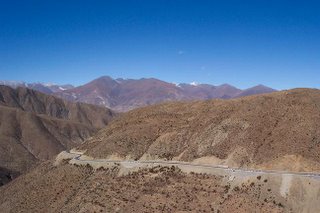
Thankfully, to ease the white-knuckled terror associated with being a passenger in such conditions, our guide had a few tapes of Tibetan favourites to distract us. Bob Marley and Tracy Chapman are SO popular here, its all you ever hear and they very much provided the soundtrack of our trip, along with a collection of best of boy bands. In fact, up to this point, "Give me one reason to stay here" could well have been our official theme song. Thankfully our remaining destinations of Shigatse (second largest city in Tibet), Guyantse and Lhasa was to redeem our opinion somewhat of Tibet.
 Shigatse (above) the Las Vegas of Tibet. Except for the casinos. The large monastary and "Stupa" of Guyantse.
Shigatse (above) the Las Vegas of Tibet. Except for the casinos. The large monastary and "Stupa" of Guyantse.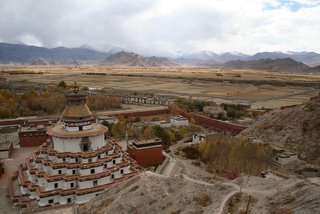

On the high wall of the fortress around Guyantse monastary. Guyantse is one of the few towns in which a traditional Tibetan village has been kept in tact and seperate from the Chinese development.
After the very basic and poverty-stricken communities of Tingri and Lhatse, it was quite the surprise to see the comparitively ultra modern communities of Shigatse, Guyantse and in particular, Lhasa, the Forbidden City. We suddenly found ourselves in nice hotels with TVs, showers, and sweet mother of God, flushing western toilets. Quite the contrast. Most of the few monastaries that survived the Communist's cultural revolution exist in these cities also, and are most impressive (see below).


Is Tibet communist?...Chinese influence is everywhere, see left and right.
Tibet before the Chinese invasion and occupation in 1951 was of course a Buddhist state headed by the Dalai Lama and despite the efforts of the Chinese, Buddhism still appears to be the dominant cultural force in the area and many Tibetans are outspokenly anti-Chinese/Communist. As mentioned above, there are still several monastaries in the larger cities and a large population of monks can often be seen around the place in their robes and surprisingly, mobile phones. One aspect of buddhism that is well and truly alive and hence taken advantage of, is the insane amount of begging that goes on. The donation of money to monks and the poor is seen as one of the major ways of gaining merit, or improving your karma. I've never seen such forceful begging, you can barely walk 10m without someone sticking their hands out saying "money, money". They'll often grab you and harass you for some time down the street.
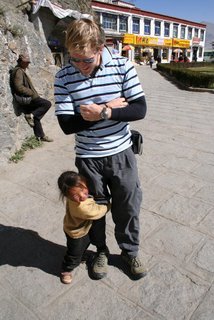
Yep, just like in Australia, ze ladies can't keep their hands off me... one of the more persistent examples of children beggars.

Many Tibetans are quite the budding capitalists also, despite the communist regime and they'll try to fleece your money out of anything, but particularly photos. A photo of anything costs money, for example, you try and take a photo of one of the 1 billion yaks in Tibet, and before you know it you're getting harrassed to pay often several dollars for it. It's ridiculous, like paying for a photo of a sheep in New Zealand. One particular custom that I thought was great and one that the west could certainly learn from is that Tibetan women, instead of wearing a wedding ring to signify their commitment, wear an apron at all times. Gold Jerry, gold.
For such a communist country, its quite funny to see so many swastikas, an ancient Buddhist symbol, plastered all over the place.


The large monastary of Shigatse, several Dalai Lamas are buried there.
Lhasa is of course the ultimate destination for most travellers in Tibet and most Buddhist pilgrims in fact. We had visions and expectations of a mystical and untouched city at the foot of the majestic Potala Palace. This expectation was quickly cast aside as we drove down the 6-lane concrete highway into the centre, passing giant department stores, hotels and business centres along the way. The Potala was typically very impressive but the giant concrete square and communist monuments everywhere tended to rob the place of its mystery.
The money shot of Tibet, the majestic Potala Palace which dominates Lhasa. Below is a view from the top of the palace over the giant communist square which I imagine is used for massacres and other assorted communist activities.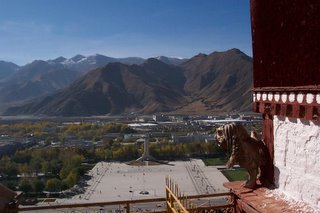
We had 5 days to ourselves in Lhasa as we parted company with our guide upon arrival. Quickly realised that there isn't in fact a lot to do in Lhasa except visit various monastaries and at the risk of sounding quite the cultural neanderthal, once you've seen one monastary you've seen them all it feels like. I'm sure that's not the case but it certainly didn't help when the extent of any tour by our guide consisted of "This is monastary. Monks live here. Ok bye." In any case much of my time was spent squatting over our hostel's toilet, spewing forth watery bodily fluids from every orifice, ears excluded. On my rare escapes from the porcelain prison (parole conditions dictated that I was never more than the aforementioned two minute call distance away) we kept ourselves occupied by checking out the obligatory monastaries, walking the markets, seeing a chinese dubbed version of War of the Worlds (why the hell did all the aliens just die? Where on earth did Robbie come from? How did Tom's car survive a 747 landing on it?) and also hanging about in crappy, smoke-filled internet cafes...
Anyways, I've included a few more photos of the landscapes and general scenes we encountered below but in general and when we get our next batch of photos on CD, I'll try and post some photos of inside the monastaries and Potala. But as "interesting" as Tibet was, I can honestly say I'm very much looking forward to getting back into the clean air of the mountains, the Annapurna circuit is up next. Still, I hope I haven't sounded negative at all about Tibet, if you enjoy rough off-road driving, exceptionally rude crowds of pickpocketing pilgrims, beggars, funky air, spitting, crapping your pants, and Bob Marley, Tibet could be just the place for you....
Til next time. 




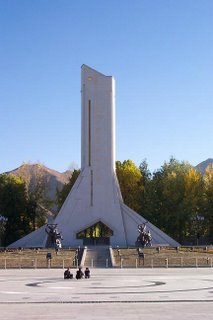
No comments:
Post a Comment